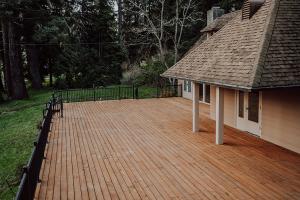Researchers confirm preservatives used in todays' preserved wood won't contaminate soil or rainwater runoff
Oregon State University study proves preservatives stay in the wood, protecting it from decay and insect attack, not leaching into soil or rainwater runoff
The study confirms the preservative in pressure-treated wood used by consumers will stay right where it belongs, protecting the wood from decay and insect damage, not leaching into the environment.”
VANCOUVER, WA, UNITED STATES, June 3, 2025 /EINPresswire.com/ -- Researchers at Oregon State University have confirmed decks built with today’s pressure-treated preserved wood products cause no environmental harm from preservative chemicals leaching from the wood and into rainwater or surrounding soil. — Dr. Gerald Presley, Oregon State University
The researchers collected runoff and soil samples the first and fourth years after construction of a deck built with wood pressure treated with Copper Azole (CA-C), the preservative used to treat the preserved wood sold for decks and other residential projects. The deck is located in Oregon’s Willamette Valley, where rainfall measures 40-60 inches each year. Sampling began with the first rains after the deck surface was completed in October 2021.
Samples were analyzed for concentrations of copper, the primary active ingredient in CA-C. The highest copper concentrations were found in samples taken at the very start of the study, shortly after the deck was completed. According to lead researcher Dr. Gerald Presley, that was to be expected.
“Those higher initial levels are due to residual surface deposits of preservative not fully absorbed into the wood fiber washing off with the rain,” he explained. “But even those highest copper concentrations were quite low.”
Within a few months, Presley said, the copper concentrations in rainwater runoff samples stabilized to well below one part per million (ppm). Similarly, copper levels in soil samples taken from directly beneath the deck and points downslope from the deck were indistinguishable from those taken upslope from the deck.
“Two years in, samples from below the deck did not differ from other locations. We could not detect any copper increase resulting from the preserved wood deck,” Presley stated. Copper in soil samples ranged from 50.3 ppm to 54.4 ppm, well within the normal range for background copper levels in the Willamette Valley and significantly below the 140 ppm threshold the Oregon Department of Environmental Quality considers to be “elevated.”
OSU researchers returned to the deck in its fourth year of service to sample rainwater runoff again. In samplings taken during the fall of 2024, copper concentrations were dramatically lower than the already low concentrations found in the initial sampling. The average copper concentration of all runoff samples collected in the fourth year was well below 0.5 ppm. These data prove that preservative loss from preserved wood decking remains negligible as the structure ages.
Presley said the study confirms that preservatives in pressure-treated wood used by consumers will stay right where they belong, protecting the wood from decay and insect damage. The study's results refute concerns often voiced on the internet and elsewhere about the dangers of preservatives from preserved wood polluting the environment.
“Often lost to these unfounded fears are the many benefits of using preserved wood,” said Butch Bernhardt, executive director of Western Wood Preservers Institute (WWPI). “The wood is sustainable, renewable and easy to maintain. Thanks to pressure treating with preservatives, those decks and other projects can last for decades in place.”
Bernhardt said the wood deck study and an earlier OSU research project confirming the safety of preserved wood garden boxes offer science-based answers to questions consumers have about using preserved wood.
“Some people have concerns. We get that, it’s only natural,” he said. “The takeaway from these studies is there’s no reason to be worried about the preservatives causing damage. People can relax and appreciate the natural warmth, long life and simple enjoyment these preserved wood decks and garden boxes have to offer.”
Initial findings from Dr. Presley’s deck study, Monitoring metal migration from a pressure-treated and sealed deck, were published in the Proceedings of the International Research Group on Wood Protection in 2024. The complete peer-reviewed study is expected to be published later this year. Dr. Presley, PhD, is an assistant professor in Oregon State University’s Dept. of Wood Science and Engineering.
A white paper detailing the deck study is available from WWPI at https://wwpi.info/IRG-OSU-DeckStudy. Details on the OSU garden box study are available in the publication PreserveTech: Safe Garden Boxes Using Preserved Wood at https://wwpi.info/PWGardenBoxes.
# # #
About WWPI
WWPI represents preserved wood treaters, preservative manufacturers and others serving the industry throughout western North America. For more than 75 years, WWPI has provided technical support and market outreach supporting the use of preserved wood in outdoor applications.
Timm Locke
Western Wood Preservers Institute
+1 503-806-4831
timm@wwpi.org
Legal Disclaimer:
EIN Presswire provides this news content "as is" without warranty of any kind. We do not accept any responsibility or liability for the accuracy, content, images, videos, licenses, completeness, legality, or reliability of the information contained in this article. If you have any complaints or copyright issues related to this article, kindly contact the author above.

